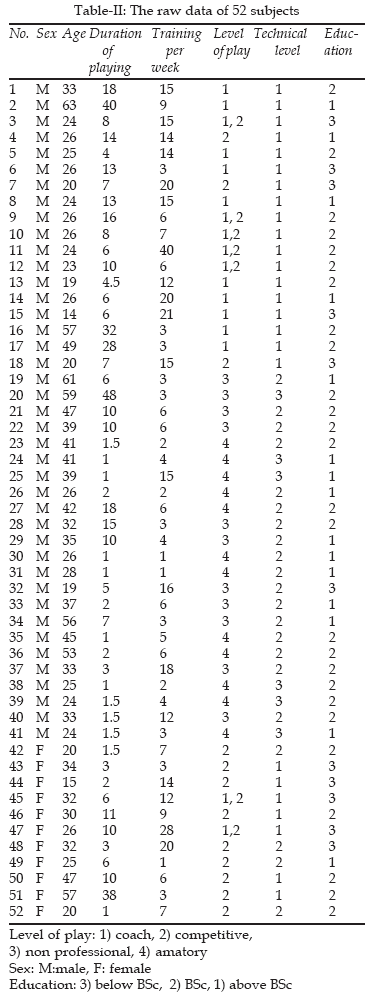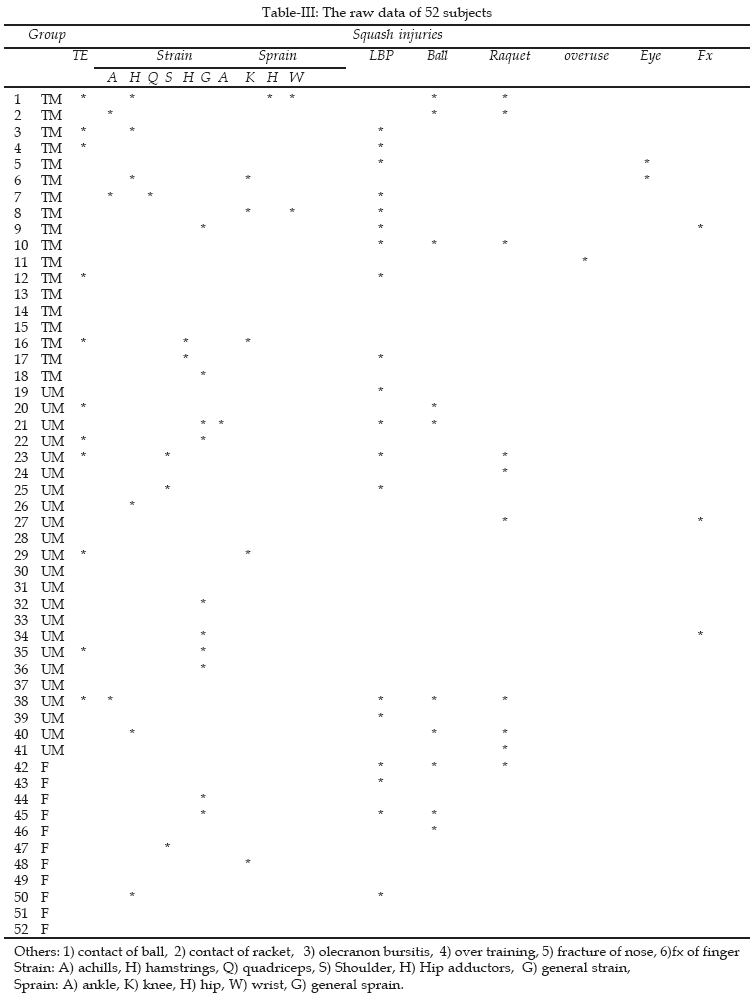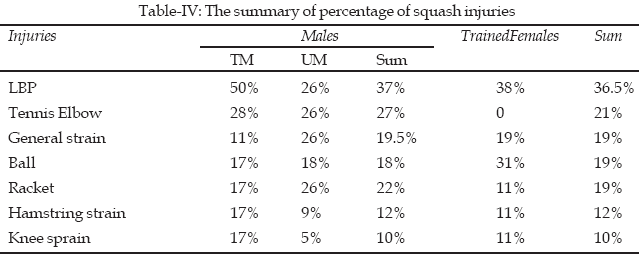|
|
||||
|
Published by : PROFESSIONAL MEDICAL PUBLICATIONS |
||||
|
ISSN 1681-715X |
||||
|
||||
|
- |
||||
|
ORIGINAL ARTICLE |
||||
|
- |
||||
|
Volume 25 |
April - June 2009 (Part-II) |
Number 3 |
||
|
|
||||
|
|
||||
|
|
||||
|
Published by : PROFESSIONAL MEDICAL PUBLICATIONS |
||||
|
ISSN 1681-715X |
||||
|
||||
|
- |
||||
|
ORIGINAL ARTICLE |
||||
|
- |
||||
|
Volume 25 |
April - June 2009 (Part-II) |
Number 3 |
||
|
|
||||
|
|
||||
Sport injuries in squash
Farshad Okhovatian1, Ezatolahi AH2
ABSTRACT
Objective: Investigating the squash injuries in the Iranian Squash Federation players.
Methodology: We prepared a questionnaire and interviewed fifty-two players.
Results: The majority of injuries were due to LBP (36.5%), which may result from the combination of rotational and sagittal plane activity of the back motion. The higher percentage of tennis elbow (21%) shows the significant function of the wrist. The knee problems may be due to playing with flexed knees and sudden changes in direction as well as to twisting movements because of the small court and the speed of ball. The most of female and male players suffered from ball & racket kicking, respectively. The reason for the first one might be due to the lack of good racket control and the second one could be owing to the incorrect motions in the court.
Conclusion: Low Back Pain (LBP) is the most common injury in squash players.
KEY WORDS: Squash, Sport injury, Racket playing.
Pak J Med Sci April - June 2009 (Part-II) Vol. 25 No. 3 413-417
How to cite this article:
Okhovatian F, Ezatolahi AH. Sport injuries in squash. Pak J Med Sci 2009;25(3):413-417.
1. Farshad Okhovatian,
Professor of Physiotherapy,
Physiotherapy Research Center,
Shaheed Beheshti University of Medical Sciences,
2. Ezatolahi AH,
Asia Squash Federation (ASF) Coach & Referee,
Squash Federation in Enghelab Sport Complex,
Iran.
Correspondence
Prof. Farshad Okhovatian,
Physiotherapy Department,
Mehr Hospital,
West Zartosht Ave,
Tehran, Iran. 1415751151.
E-mail: farshadi2000@hotmail.com
* Received for Publication: December 13, 2008
* Revision Received: December 19, 2008
* Revision Accepted: April 18, 2009
INTRODUCTION
Squash is an indoor racket game that is played in a four-walled court. Chard & Lachman¹ have found out that squash players face up more injuries (59%) in comparison with the tennis (21%) and badminton (21%) ones. On the other hand, injuries to the lower limbs in squash are common² and relate to the acute physical stresses increase in the nature of the sport, as well as the more chronic overuse type of injuries. Since players are active for the most time of the game, they may face more sport injuries. However, so far there is no study which has documented injuries in squash players in Iran.
Therefore, the aim of this study was to investigate the injuries of squash over the last two years in the players of the Squash Federation in Engelab Sport Complex (SFESC), which is a biggest sport complex in Iran.
METHODOLOGY
We prepared a questionnaire and collected data on all squash players who registered on SFESC as a squash player (immature, non professional, competitive, coach) within one month, about the injuries they had from September 2006 to September 2008. All questionnaires were completed during the interviews of player conducted by two interviewers, (i.e., a professional coach player and a professional physiotherapist for sport injuries). The authors obtained permission and consent of all players and Iranian Squash Federation to do this research.

RESULTS
Fifty-two questionnaires were completed from all squash players who registered on the SFESC during a month. Their level of playing consists of 18 competitive and coach males, 23 amateur and non professional males and 11 competitive and coach females.
Their levels of education might be divided into below BSc (21%), BSc (52%) and MSc or above (27%). About 80% of players were either BSc or above BSc degrees which can emphasize on their consideration and carefulness during the filling of questionnaire. Forty-one of the 52 players (79%) mentioned sustaining at least one injury during squash participation over the last two years.

The most of the injuries sustained (36.5%) were lower back pain (LBP). Tennis elbow (21%), general muscle strain (19%), racket kicking (19%) and ball kicking (19%), hamstring strain (12%), knee sprain (10%) were the other most commonly reported injuries. All players were using squash shoe and our results show that the use of protective equipment included wrist support (29%), elbow support (2%), ankle support (2%), knee support (6%) and protective eyewear (10%). Tables-II & III show our raw data about subjects’ personal, training and injuries information.

DISCUSSION
Playing squash is an excellent way to obtain an excellent cardio-vascular function. The players’ arms swing the racket and their legs run around the court. Thus, to play at a decent level you need to be fit and have a strong leg and arm. In this study, we considered the technique level of players and our results show that majority of players had good and moderate technique level (88%).

Upper Extremities:
Silva et al have mentioned that "Our study highlights the need for coaches, physicians and players to be aware of distal humeral pain and understand treatment options in order to prevent further injury, including stress fractures."²Although, the shoulder and arm are extensively used in squash, the control and drive of the racket and the ball come from the wrist, so it is important to train specifically the muscles of wrist. In our study, 21% of players mentioned that, they feel some pain in the forearm and lateral side of elbow areas on their dominant side. In addition, our results show that the most usage of the splint in the players was wrist support (29%). This result emphasizes on the significant function of the wrist in squash, therefore the trainers should have a specific consideration on the strengthening of wrist muscles in the beginners.
Trunk:
Results from this study also shows that the majority of players had suffered from LBP (36.5%). The study conducted by Alyas et al,³ confirms our findings. They report, "Abnormalities were frequent, predominately in the lower lumbar spine, almost exclusively at L4/5 and L5/S1 levels."³ Squash players may be at a risk of LBP from the combination of rotational and sagittal plane activity of the back motion during squash. The authors suggest that more research is needed to study the lumbar problems in squash players.Lower Extremities:
We found that the most of muscular strain occurred on hamstring muscles and 10% of players suffered from knee injuries. The knee problems in squash players may be due to playing with flexed knees and sudden changes in direction as well as to twisting movements because of the small court and the speed of ball.In the present study, few players have suffered from ankle sprain and Achilles tendon injuries (2% and 6%, respectively).This supports the results of Chard & Lachman who reported that Achilles tendon injuries were not more frequent in squash.¹
Eye injury: Squash is a dangerous activity for eye. In sever cases, if the squash ball hits the eye hard enough, it can burst the eyeball, which may result in the loss of the injured eye. The data provided by Eime & Finch 4 have suggested that "self reported use of protective eyewear has probably increased over the past decade. However, many players have reported that they are wearing inappropriate eyewear.
4 According to this study; a few of SFESC players (4%) reported the eye injury and just 10% used eyewear. We therefore suggest that the manager of SFESC and other clubs should pay extra attention to this otherwise these injuries might happen due to this carelessness.The gender effect in squash injury: In this study, forty-one of 52 players were male and 11 of them were female. The frequency of squash injuries was the same in both gender except on tennis elbow and ball and racket kicking. We wonder why women players did not have tennis elbow! The authors suggest that it could be due to the way they play in the court i.e., gently and smoothly.
Our studies have showed that one of the common injuries, in both genders were caused by ball and racket kicking (19%). Based on the results, we suggest that the comparison between trained male and trained female players is not a suitable one; because there is a great difference between these two groups. This may result from special cultural situation in our country. Therefore we compared untrained male and trained female players.
In comparing these two groups, we found out that the untrained males suffer from racket kicking more (26%) which could be due to their energetic character of playing with weak technical ability and wrong direction in the courts. On the other hand, the female players had more injuries from ball kicking (31%) that could be due to their weakness in the racket control.
The training and technical level in squash injuries:
We also compared the squash injuries between trained and untrained male players. The trained male when compared with untrained male suffered more from LBP (50% to 26% i.e., trained to untrained respectively), hamstring strain (17% to 9% i.e., trained to untrained respectively) and knee sprain (17% to 5% i.e., trained to untrained respectively). The intensive playing situation and hard training program of trained males may explain this difference. On the other hand, higher general strain in untrained male (11% to 26% i.e., trained to untrained respectively) may show their poor technique and fitness levels.Some other studies indicate that injury was often seen in beginner players and those who played infrequently at a low competitive level.¹ Our research contradicts the result of above authors, and we did not find fewer injuries in competitive and coach males in comparison with non professional ones. We suggest that the professional players face more chronic injuries, because of their playing duration (13.4 to 6.5 years i.e., trained to untrained respectively), the training time per week (13.2 to 5.7 hours i.e., trained to untrained respectively) and also the intensive playing, as compared with non professional male.
CONCLUSIONS
Though other studies suggested that majority of injuries in squash occur on the lower extremities, this study showed that the most squash injuries occur in trunk and upper limbs respectively. However further research regarding injuries in this sports is needed.
REFERENCES
1. Chard MD, Lachman SM. Racquet sports-patterns of injury presenting to a sports injury clinic, Brit J Sports Med 1987;21(4):150-3.
2. Silva RT, Hartmann LG, Laurino CF. Stress reaction of the humerus in tennis players, Brit J Sports Med 2007;41(11):824-6.
3. Alyas F, Turner M, Connell D. MRI findings in the lumbar spine of asymptomatic, adolescent, elite tennis players. Brit J Sports Med 2007;41(11):836-41.
4. Eime RM, Finch CF. Have the attitudes of australian squash players towards protective eyewear changed over the past decade? Brit J Sports Med 2002;36(5):442-5.
HOME | SEARCH | CURRENT ISSUE | PAST ISSUES
Professional
Medical Publications
Room No. 522, 5th Floor, Panorama Centre
Building No. 2, P.O. Box 8766, Saddar, Karachi - Pakistan.
Phones : 5688791, 5689285 Fax : 5689860
pjms@pjms.com.pk